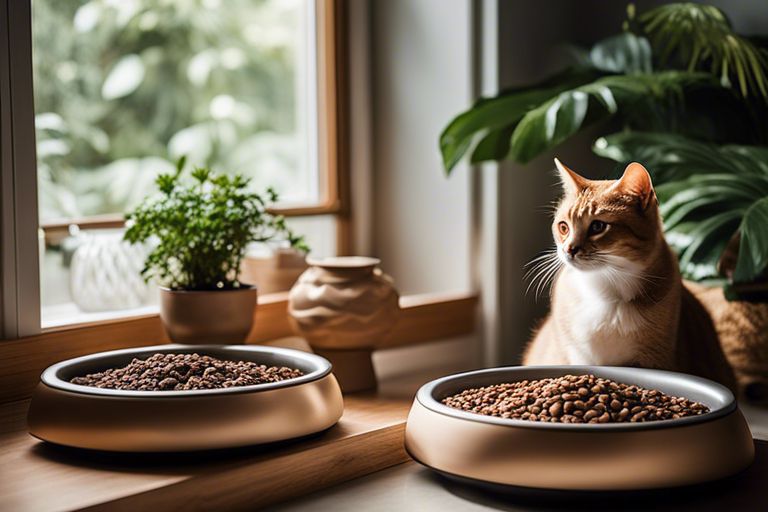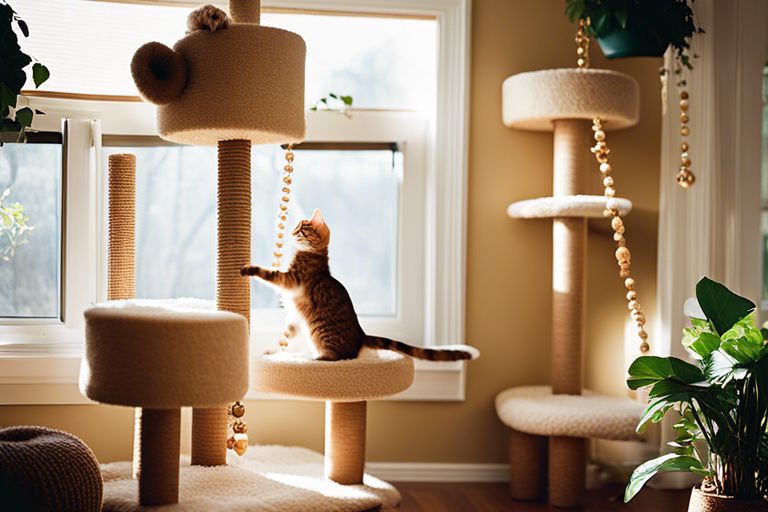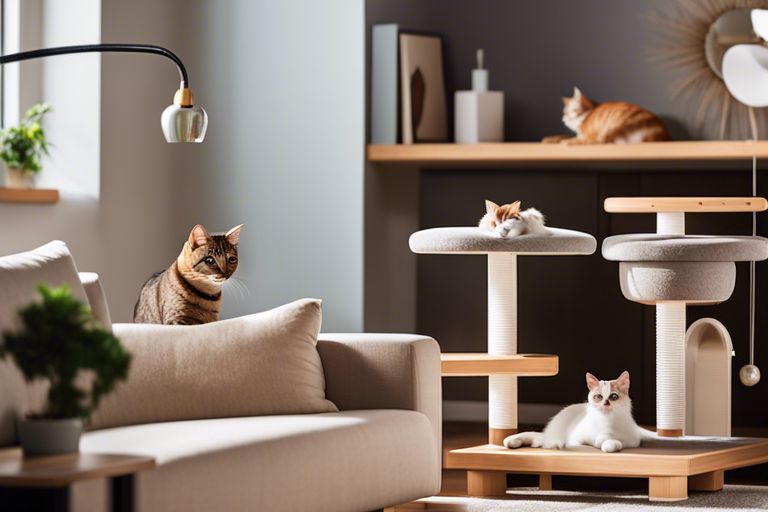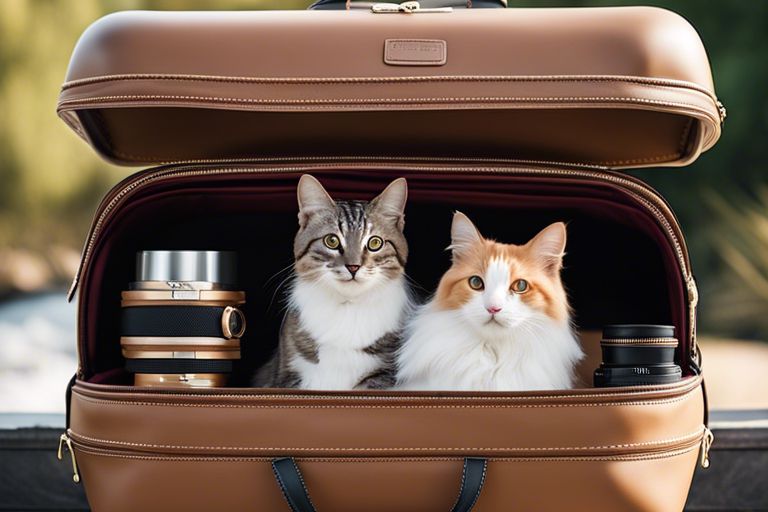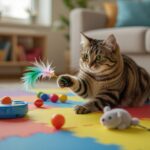Quintessentially, our feline friends are known for their discerning tastes, and this applies to their dining preferences as well. Finding the ideal cat food and water bowls is essential for ensuring your furry companion’s mealtime bliss. In this tutorial, we will explore the factors to consider when selecting the perfect bowls for your cat, as well as provide recommendations for top-rated options on the market.
When it comes to choosing the best cat food and water bowls, there are numerous factors to take into consideration, ranging from material and size to design and functionality. With the plethora of options available, it can be overwhelming to determine which bowls will best suit your cat’s needs. From stainless steel and ceramic to elevated and automatic feeders, we will delve into the pros and cons of each type of bowl to help you make an informed decision. By the end of this tutorial, you’ll be equipped with the knowledge to find the perfect cat food and water bowls to enhance your furry friend’s mealtime experience.
Key Takeaways:
- Importance of Material: Consider using stainless steel or ceramic bowls to prevent allergic reactions and bacterial growth.
- Size Matters: Choose bowl sizes that are appropriate for your cat’s breed and feeding habits to ensure they are getting the right portion and preventing overeating.
- Separate Bowls: Provide separate bowls for food and water to maintain hygiene and prevent contamination.
- Easy to Clean: Opt for bowls that are easy to clean and dishwasher safe to maintain proper hygiene and freshness of food and water.
- Consider Elevated Bowls: Elevated bowls can improve posture and digestion for cats, especially for older or arthritic pets.
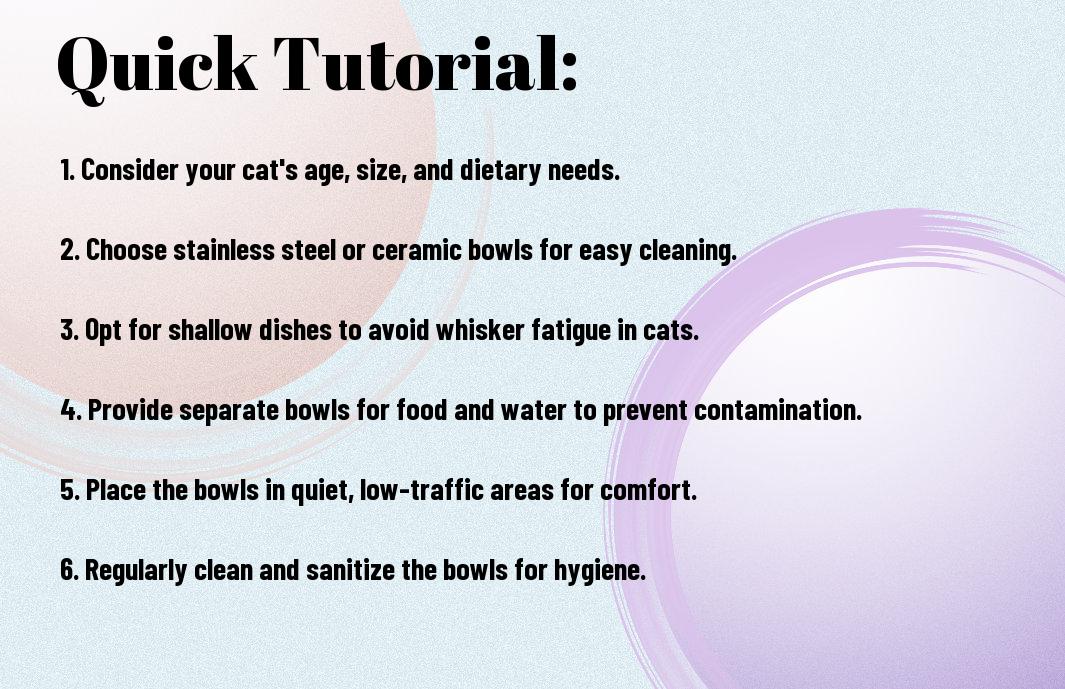
Understanding Your Cat’s Needs
While cats may seem like low-maintenance pets, they have specific needs that must be met in order to ensure their overall health and well-being. One of the most crucial aspects of caring for a cat is providing them with the proper food and water bowls. Understanding your cat’s individual needs and behaviors will help you choose the right bowls to meet their specific requirements.
Exploring Feline Feeding Behavior
To properly cater to your cat’s feeding habits, it’s essential to understand their natural instincts and behaviors. Cats are solitary hunters by nature, and they prefer to eat small, frequent meals throughout the day. Additionally, cats have sensitive whiskers and may be averse to eating from deep or narrow bowls that touch their whiskers. Understanding these behaviors will help you select the right bowls for your feline friend.
Importance of Bowl Size and Shape
Size and shape play a critical role in your cat’s feeding experience. Cats have a preference for shallow, wide bowls that allow them to easily access their food without feeling confined. Additionally, the size of the bowl should be proportionate to your cat’s size, ensuring that they have enough space to eat comfortably. For instance, a large, deep bowl may cause discomfort for a smaller cat, while a shallow, wide bowl may be more suitable for their needs.
Types of Cat Food Bowls
To ensure your feline friend’s mealtime bliss, it’s crucial to choose the right type of cat food bowl. There are various options available in the market, each with its own set of pros and cons. Let’s take a closer look at the different types of cat food bowls to help you make an informed decision for your fur baby.
This information is presented in the table below to give you a comprehensive overview of the various types of cat food bowls and their characteristics:
| Types of Cat Food Bowls | Pros and Cons |
|---|---|
| Plastic Bowls | |
| Ceramic Bowls | |
| Stainless Steel Bowls | |
| Automatic Feeders |
Plastic Bowls: Pros and Cons
Cons: Plastic bowls may harbor bacteria and are prone to scratches, which can harbor even more bacteria. They can also cause chin acne in some cats due to their porous nature. Additionally, some cats may develop allergies to certain plastics. Despite being lightweight and affordable, these factors should be carefully considered before choosing a plastic bowl for your cat.
Pros: Plastic bowls are widely available and come in a variety of colors and designs. They are also less likely to break if dropped compared to other materials, making them a durable option for rough-and-tumble kitties.
Ceramic Bowls: Pros and Cons
Bowls: Ceramic bowls are heavy and less prone to tipping over, providing stability during mealtime. They are also non-porous, making them resistant to bacterial growth and easy to clean. The weight of ceramic bowls can be both a pro and a con, as it provides stability but can be difficult to move around.
Cons: There is a risk of ceramic bowls chipping or breaking if dropped, posing a potential hazard to your cat. Additionally, some ceramic glazes may contain lead or other harmful substances, so it’s important to choose food-safe options when selecting a ceramic bowl for your cat.
Plus, ceramic bowls are a stylish choice and can add a touch of elegance to your cat’s dining area. They are also suitable for cats with chin acne or allergies to plastic.
Stainless Steel Bowls: Pros and Cons
Cons: Stainless steel bowls can be noisy when your cat eats, and they may not stay in place as well as heavier options such as ceramic bowls. Additionally, some cats may be averse to the metallic taste of stainless steel, leading to mealtime reluctance.
Steel: On the flip side, stainless steel bowls are durable, non-porous, and resistant to bacterial growth. They are also lightweight and easy to clean, making them a practical choice for cat owners.
Automatic Feeders: Pros and Cons
Cons: Automatic feeders may malfunction, leading to irregular meal times for your cat. They also require regular cleaning and maintenance to prevent bacterial buildup and ensure proper portion control.
Pros: Automatic feeders are convenient for busy pet owners and help maintain a consistent feeding schedule for your cat. They can also prevent overeating and obesity by dispensing controlled portions throughout the day.
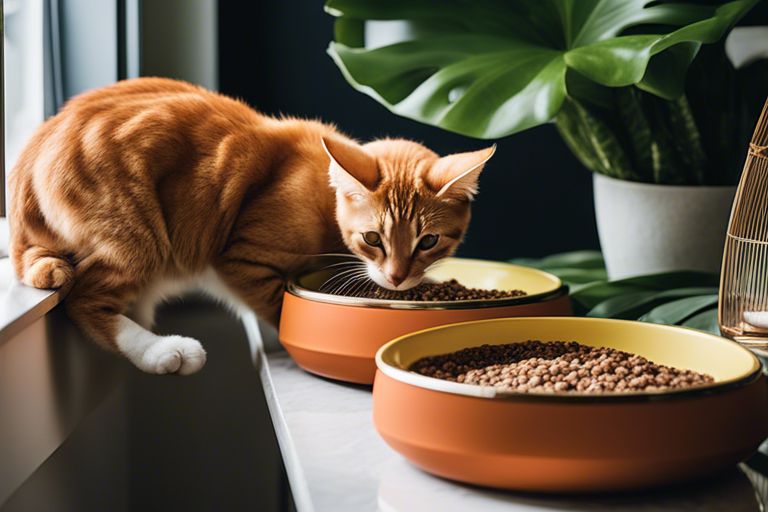
Types of Water Bowls and Dispensers
Not all water bowls and dispensers are created equal. When it comes to finding the perfect one for your cat, it’s important to consider the different types available and how they may benefit your furry friend.
Importantly, the information should be broken down into a table with 2 columns and 5 rows.
Standard Water Bowls
Water bowls are the most common and basic option for providing water to your cat. They come in a variety of materials, including plastic, ceramic, and stainless steel. While plastic may be inexpensive, it can harbor bacteria and should be replaced regularly. Ceramic and stainless steel options are more durable and easier to clean.
Water Fountains for Cats
Standard water bowls are suitable for many cats, but some felines prefer running water. Water fountains for cats provide a continuous flow of fresh, filtered water, which can encourage your cat to drink more and stay hydrated.
With the ability to mimic a natural water source, water fountains for cats can be particularly beneficial for cats who are hesitant to drink from still water sources.
Gravity Water Dispensers
An alternative to traditional water bowls, gravity water dispensers use the force of gravity to keep the water dish full. As your cat drinks, the water is automatically refilled from the reservoir, ensuring a constant supply of fresh water.
Water dispensers are ideal for busy pet owners who may not be able to refill their cat’s water bowl multiple times a day. They also provide an option for cats who prefer drinking from a constantly replenished water source.
The Debate: Separate vs. Combined Bowls
Despite the ongoing debate, whether to use separate or combined bowls for your cat’s food and water, there are valid points to consider for each option. This debate has sparked numerous discussions among cat owners, and it can be challenging to determine which is the best choice for your feline friend. If you are still undecided, it can be helpful to seek advice from other pet owners who have faced the same dilemma. For example, click here to read what other pet owners have to say about feeding a pregnant cat.
Advantages of Separate Bowls
For cats who are picky eaters or have specific dietary needs, using separate bowls for food and water can help prevent any contamination or interference between the two. This approach allows for better control over portion sizes and monitoring of food intake and water consumption. Additionally, it can encourage better hydration as the cat will have separate access to fresh, clean water without any food particles or debris.
Moreover, some cats may have a preference for eating away from their water source. This is especially true for cats who have a more sensitive palate and prefer a certain ambiance while they dine. Having separate bowls gives the cat the freedom to choose their preferred location for eating and drinking.
Advantages of Combined Bowls
Separate bowls require additional space, and in some cases, may not be practical in smaller living quarters. Combined bowls can offer a space-saving solution, making it easier to manage and maintain a tidy feeding area. Additionally, some cats may enjoy the convenience of having their food and water in close proximity, especially if they prefer to graze throughout the day.
Furthermore, using combined bowls can be more aesthetically pleasing and can help create a designated feeding area for your cat. This setup can also be advantageous for pet owners who like to maintain a minimalistic and organized living space.
Debate over the pros and cons of each option will continue, but ultimately, the decision will depend on your cat’s individual preferences and needs.
Making the Best Choice for Your Cat
Combined bowls can be the best choice for your cat if space is limited, and your cat prefers to have easy access to both food and water. Additionally, if you prefer a more streamlined and organized feeding area, combined bowls can be the ideal choice.
On the other hand, separate bowls may be the best choice for your cat if they have specific dietary or behavioral needs that require strict portion control and monitoring. Additionally, if your cat prefers to eat and drink in different locations, separate bowls can accommodate their preferences more effectively.
Positioning and Placement of Bowls
Your cat’s mealtime experience can be greatly affected by the positioning and placement of their food and water bowls. It is important to consider the safety and accessibility of the locations where you place these bowls, as well as any considerations for multiple cat households.
Safe and Accessible Locations
For your cat’s comfort and safety, it is essential to place their food and water bowls in a quiet, low-traffic area of your home. This will help reduce stress during mealtime and create a calm environment for your cat to eat and drink. Additionally, be sure to place the bowls away from their litter box, as cats prefer to keep their dining area separate from their bathroom area.
Consideration for Multiple Cat Households
Positioning the food and water bowls for multiple cat households requires careful consideration. It is important to provide enough space between the bowls to prevent competition and potential conflicts between cats. In addition, consider placing the bowls in different areas of the home to provide each cat with their own dining space, reducing the likelihood of territorial disputes.
Bowls should be placed in areas where each cat feels comfortable and secure, and it may be necessary to adjust the placement of the bowls to accommodate the needs and preferences of all cats in the household. By carefully considering the positioning and placement of the bowls, you can help create a harmonious mealtime experience for all of your furry companions.
Hygiene and Maintenance
Unlike humans, cats are not too concerned about maintaining the cleanliness of their eating and drinking utensils. It is up to us, as responsible pet owners, to ensure that their food and water bowls are kept clean and sanitary at all times.
Cleaning and Sanitizing Bowls
Any leftover bits of food can quickly become a breeding ground for bacteria and other harmful microorganisms. It is important to wash your cat’s food and water bowls after every meal with hot, soapy water. Additionally, a regular deep cleaning and sanitizing is necessary to prevent the buildup of germs. You can use a solution of one part white vinegar to three parts water to thoroughly clean and sanitize the bowls at least once a week.
Tips for Maintaining Water Freshness
One of the best ways to ensure that your cat’s water stays fresh is to change it at least once a day. Consider investing in a water fountain for your feline friend, as moving water tends to stay fresher for longer. Knowing that cats tend to be finicky about their water sources, try using a shallow, wide bowl rather than a deep one. This will help prevent their sensitive whiskers from touching the sides of the bowl, which can be uncomfortable for them.
- Change water daily
- Consider a water fountain
- Use a shallow, wide bowl
A clean, hygienic environment is crucial in maintaining your cat’s health and well-being, and this includes providing fresh, clean water and regularly washing their food and water bowls. By following these simple tips, you can ensure that your feline friend is happy, healthy, and properly nourished.
Recognizing When to Replace Bowls
One sign that it may be time to replace your cat’s food and water bowls is if they start to show signs of wear and tear, such as scratches, cracks, or stains that cannot be removed. Additionally, if you notice that your cat is hesitant to eat or drink from their bowls, it may be time for a replacement. Cats have sensitive senses, and any lingering odors or flavors in the bowls can deter them from mealtime bliss.
Replace your cat’s food and water bowls if you notice any signs of wear, such as scratches, cracks, or stains that cannot be removed. Your cat’s health and happiness depend on it.
Tutorial: Choosing and Setting Up Your Cat’s Dining Area
After bringing a new cat into your home, one of the first steps is to create a comfortable and functional dining area for your feline friend. This involves more than just placing a couple of bowls on the floor. By following a few simple steps, you can ensure that your cat’s dining area promotes healthy eating habits and a positive mealtime experience.
Any decision regarding the type and placement of your cat’s food and water bowls should start with an assessment of your cat’s size and eating habits. This will help you determine the appropriate bowl size and shape to accommodate your cat’s needs. Additionally, understanding how your cat likes to eat can guide you in selecting the right bowls that will make mealtime more enjoyable for your pet.
Step 2: Selecting the Ideal Bowls
Selecting the ideal food and water bowls for your cat involves considering factors such as material, shape, and depth. Stainless steel, ceramic, and glass are popular choices for cat bowls, each offering its own benefits. Wide, shallow dishes are often preferred for cats, as they prevent whisker stress and make eating more comfortable. Additionally, choosing separate bowls for food and water can help keep them hygienic and easily accessible for your cat.
Area When selecting the ideal bowls for your cat, consider the overall aesthetic of your home and how the bowls will fit into your cat’s dining area. Opt for bowls that are easy to clean and maintain, ensuring a sanitary environment for your pet. Additionally, look for bowls that are durable and stable, reducing the risk of spills and messes during mealtime.
Step 3: Deciding on the Bowl Material
To make an informed decision on the bowl material, consider factors such as durability, hygiene, and weight. Stainless steel bowls are durable and easy to clean, while ceramic bowls offer a more aesthetic appeal. Glass bowls are another option, providing a non-porous surface that resists bacteria and odors. Plus, the weight of the bowl can also impact its stability and resistance to tipping over, especially if you have a lively or rambunctious cat.
Step 4: Determining the Best Location for Placement
Step When determining the best location for placing your cat’s food and water bowls, consider the traffic flow in your home, as well as the proximity to your cat’s favorite resting spots. For instance, placing the bowls away from high-traffic areas and noisy appliances can create a calm and inviting dining environment for your cat. Additionally, keeping the bowls away from litter boxes can help prevent contamination and maintain a clean dining area.
Step 5: Establishing a Cleaning Routine
Best It’s important to establish a regular cleaning routine for your cat’s food and water bowls. This not only promotes a hygienic dining environment but also helps prevent the growth of bacteria and mold. Use mild, pet-safe cleaning products and wash the bowls thoroughly after each use. Additionally, consider replacing the bowls periodically to ensure they remain in good condition for your cat.
Step 6: Introducing the Bowls to Your Cat
Bowl Proper placement of the food and water bowls can help your cat associate mealtime with a positive experience. Place the bowls in a quiet, accessible location and encourage your cat to approach the bowls at their own pace. Avoid placing the bowls too close to each other to prevent interference while eating or drinking. Additionally, monitor your cat’s reaction to the new bowls and make any necessary adjustments to ensure they feel comfortable and relaxed during mealtime.
Step 7: Observing and Making Adjustments
Establishing When observing your cat’s behavior during mealtime, pay attention to factors such as eating speed, food consumption, and water intake. If you notice any changes in these patterns, consider making adjustments to the type or placement of the bowls. Observing your cat’s habits and making necessary changes will help ensure that their dining area promotes healthy eating and drinking habits.
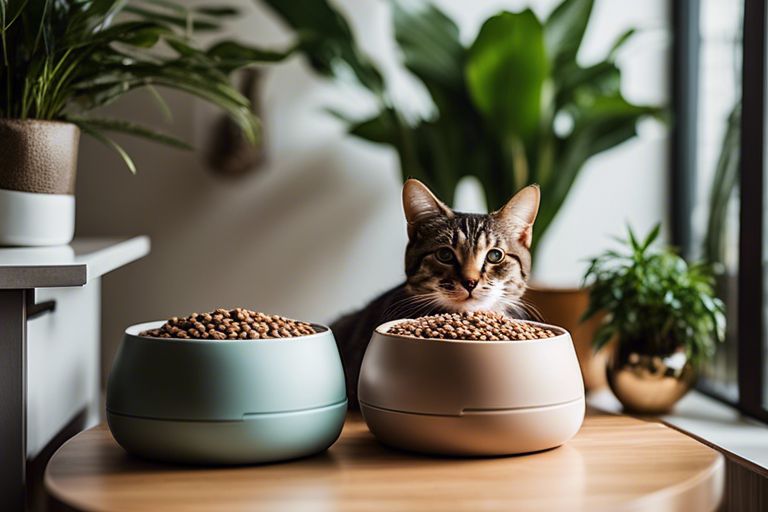
Conclusion
From above, it is clear that finding the perfect cat food and water bowls is crucial for ensuring mealtime bliss for your feline companion. By considering factors such as size, material, and accessibility, you can choose the best bowls that meet your cat’s needs and preferences. This not only promotes healthy eating habits but also helps prevent potential health issues.
It is important to invest in high-quality and durable cat food and water bowls to ensure the safety and well-being of your pet. Remember to regularly clean and inspect the bowls to maintain a hygienic feeding area for your cat. With the right bowls in place, you can create a stress-free and enjoyable mealtime experience for both you and your furry friend.
FAQ
Q: What factors should I consider when choosing cat food and water bowls?
A: When choosing cat food and water bowls, consider the material, size, and design. Stainless steel or ceramic bowls are recommended for their durability and ease of cleaning. The size of the bowls should correspond to the size of your cat, and a wide, shallow design is preferable to prevent whisker fatigue.
Q: How often should I clean my cat’s food and water bowls?
A: Cat food and water bowls should be cleaned daily to prevent the buildup of harmful bacteria and mold. Use hot, soapy water to thoroughly wash and rinse the bowls, and avoid using harsh chemicals that may leave residue.
Q: Why is it important to have separate food and water bowls for my cat?
A: It is important to have separate food and water bowls for your cat to maintain hygiene and prevent contamination. Cats are sensitive to the odor of their food, and having separate bowls prevents them from being deterred by the scent of their water.
Q: Can the placement of my cat’s food and water bowls impact their eating and drinking habits?
A: Yes, the placement of your cat’s food and water bowls can significantly impact their eating and drinking habits. Cats prefer a quiet and safe feeding area away from high-traffic areas. Additionally, placing the water bowl away from the food bowl encourages proper hydration.
Q: Are raised cat food and water bowls beneficial for my cat?
A: Raised cat food and water bowls can be beneficial for cats with arthritis, joint pain, or digestive issues. The elevated position reduces strain on the neck and back, making it easier for older or ailing cats to eat and drink comfortably.
